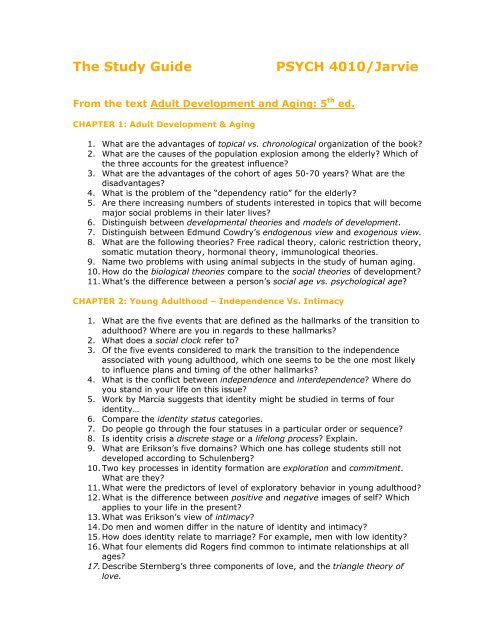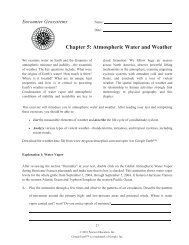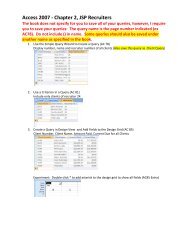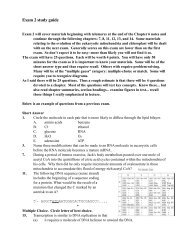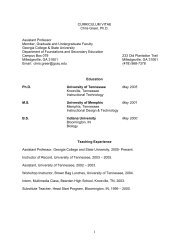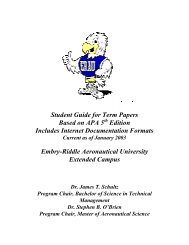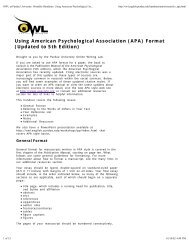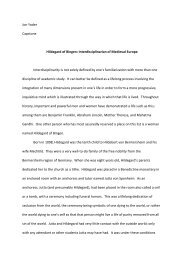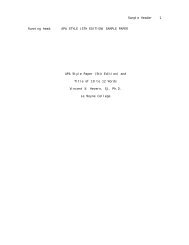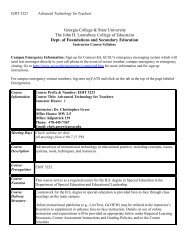study questions
study questions
study questions
- No tags were found...
You also want an ePaper? Increase the reach of your titles
YUMPU automatically turns print PDFs into web optimized ePapers that Google loves.
The Study GuidePSYCH 4010/JarvieFrom the text Adult Development and Aging: 5 th ed.CHAPTER 1: Adult Development & Aging1. What are the advantages of topical vs. chronological organization of the book?2. What are the causes of the population explosion among the elderly? Which ofthe three accounts for the greatest influence?3. What are the advantages of the cohort of ages 50-70 years? What are thedisadvantages?4. What is the problem of the “dependency ratio” for the elderly?5. Are there increasing numbers of students interested in topics that will becomemajor social problems in their later lives?6. Distinguish between developmental theories and models of development.7. Distinguish between Edmund Cowdry’s endogenous view and exogenous view.8. What are the following theories? Free radical theory, caloric restriction theory,somatic mutation theory, hormonal theory, immunological theories.9. Name two problems with using animal subjects in the <strong>study</strong> of human aging.10. How do the biological theories compare to the social theories of development?11. What’s the difference between a person’s social age vs. psychological age?CHAPTER 2: Young Adulthood – Independence Vs. Intimacy1. What are the five events that are defined as the hallmarks of the transition toadulthood? Where are you in regards to these hallmarks?2. What does a social clock refer to?3. Of the five events considered to mark the transition to the independenceassociated with young adulthood, which one seems to be the one most likelyto influence plans and timing of the other hallmarks?4. What is the conflict between independence and interdependence? Where doyou stand in your life on this issue?5. Work by Marcia suggests that identity might be studied in terms of fouridentity…6. Compare the identity status categories.7. Do people go through the four statuses in a particular order or sequence?8. Is identity crisis a discrete stage or a lifelong process? Explain.9. What are Erikson’s five domains? Which one has college students still notdeveloped according to Schulenberg?10. Two key processes in identity formation are exploration and commitment.What are they?11. What were the predictors of level of exploratory behavior in young adulthood?12. What is the difference between positive and negative images of self? Whichapplies to your life in the present?13. What was Erikson’s view of intimacy?14. Do men and women differ in the nature of identity and intimacy?15. How does identity relate to marriage? For example, men with low identity?16. What four elements did Rogers find common to intimate relationships at allages?17. Describe Sternberg’s three components of love, and the triangle theory oflove.
18. What are the differences among personal commitment, moral commitment,and structural commitment?19. How do Asian students view their relationships differently from Americanstudents?20. When Huston, McHale and Crouter examined changes in the behavior patternsof newlyweds they found what? How were these things related to maritalhappiness six years later?21. How did “courtly love” in the middle Ages change our present views onmarriage and similar relationships? Why was societal recognition of intrinsicworth important?22. Erikson argued that acquisition of religious and political belief systems areparticularly important for ego identity development. What are your politicalbeliefs, your affiliations?23. The American Council of Education has raised what concerns about collegestudents’ goals, values, and aspirations over the past 30 years?24. Why are you in college? In what ways do you expect to become involved inyour community in the next year? Five years? Ten years?CHAPTER 3: The Middle Years—Generativity and Responsibility1. What are the two reasons that middle age is described as a twentieth-centurydevelopment in the human life cycle?2. Describe Erikson’s theory of the dilemma of Generativity vs. Stagnation.3. What are the seven components of generativity according to the work ofMcAdams, et. Al.?4. How is the “sandwiched generation” defined in terms of Sequential vs.Simultaneous care of others? Where do you see yourself in the future of yourfamily?5. What is the “parental imperative”? What did your parents set aside for yourdevelopment (and of course that of your siblings)?6. What did Silverberg and Steinberg find about parents and their psychologicalinvestments both in and outside of the family?7. How do “later middle aged” parents appraise their children and how is it tiedto their own developmental stage?8. Why is it difficult to determine the directionality of the relationship betweenparents’ well being and the adjustment/attainment of their adult children?9. Where are most of the elderly cared for? Who provides care for them? Whatdo you suppose are the expectations in your family concerning the care ofyour grandparents? The care of your parents?10. What types of emotional strains do the caregivers experience?11. What is the median age for menopause? What factors are associated withearly onset? How has menopause been viewed historically? What is theconnection between menopause and depression?12. Explain the case of women in Rajput, and purdah. What implication does thishave for our views of menopause?13. What is the actual experience of menopause for most women?14. Is menopause associated with any diseases?15. What is the crisis model of development? Where did it originate?16. What is the transition model and how does it differ from the crisis model?17. Why do some studies conclude that midlife crises are common while others donot?18. What are the economic prospects of the baby boomers? How does the secondwave differ from the first wave?
CHAPTER 4: Late Life—Reintegration or Despair1. What age ranges cover the young-old, the old-old, and the very old? How dothese titles apply to your own grandparents, great aunts and uncles?2. What developmental tasks did Erikson suggest at this stage of life? Whatcomes from the resolution?3. What is the dominant theme running through Havighurst’s list of majordevelopmental tasks?4. What are some of the causes of financial worries that the very old might havethat the young-old might not?5. How does the balance of dependency and interdependence change fromadolescence to old age?6. Your authors suggest that the greatest fears of many old people concernevents that actually are very unlikely to occur. What are these fears and whyare they unlikely? What are your elders’ fears in comparison to theseconcerns?7. What percent of older persons had incomes below the official poverty level?What happens to most unmarried older people? What is it that most oldpeople need in the economic sphere?8. What percent of old people over 65 are in institutional care? How about thevery old?9. How do small town widows compare to urban widows in terms of emotionaladjustment? How do men and women differ in terms of poor health andexpectations? If your grandparent, great uncle/aunts are widowed, how dothey seem emotionally to you?10. Describe the migration pattern of retirees.11. How many old people in how many nursing homes? How have nursing homeschanged over the years? Are there adequate numbers of qualifiedprofessionals in these homes? If not, why?12. What have studies of the social ecology of nursing homes suggested?13. Why hasn’t extensive job training and job redesign improved the care of theaged in nursing homes?14. What is “gerontocracy”?15. How does social exchange theory relate to changes in altruism?CHAPTER 5: Research Methodology in Adult Development and Aging1. What is the difference between age change and age difference? Why is thisdistinction important when examining what studies on aging tell us?2. In terms of cohort, how do subjects in a longitudinal design differ fromsubjects in a cross-sectional design? (Hint: think about the example of FrankSinatra’s music).3. At GC&SU, faculty who have worked here for ten years have complained thatthe newly-hired faculty are making approximately the same salary. Use yourknowledge of cohorts and design to explain what might be going on here.4. Describe the strengths and weaknesses in longitudinal designs.5. Describe the strengths and weaknesses in cross-sectional designs.6. Describe a time-lag design. Use the sex life of your grandparents as example.7. What are some of the sampling problems found in the studies in your text?Use the “mid-life crisis” as an example. Why are representative samples lostin longitudinal designs?8. What is a “most efficient design”? Give an example.
9. Compare repeated samples vs. independent samples in a longitudinal <strong>study</strong>.What is the advantage of the independent samples?10. What kind of design might you use for the following <strong>questions</strong>?CHAPTER 6: Families1. What do we know about the likelihood of first marriages staying together untilwidowhood? How common is remarriage? Is your grandparent more or lesslikely to remarry following the death of a spouse?2. In the series of “filters” concerning the screening of intimate relationships,what is propinquity?3. In a cross-cultural <strong>study</strong> of mate selection preferences in 37 countries, innearly every culture, there were significant differences in attraction. Whatwere they?4. Where is the U.S. on the importance of having children as compared to othercountries?5. What is the “baking effect” of children on marriages?6. How does the presence of children influence marital stability? Maritalinteractions? Marital satisfaction?7. The arrival of children does not affect all couples in the same way. What isthe experience for better-educated and higher income couples?8. How do husbands and wives differ in their perceptions of what is equitable inpaid work and household work?9. How do child gender, temperament and step-status influence maritalsatisfaction?10. What are the advantages and disadvantages of younger vs. older fathers inparenting children?11. How does the quality of the relationship with the mother influence a father’sparenting involvement?12. Do most women fear the “empty nest” syndrome?13. What is the best estimate of what happens to marital satisfaction during thefirst five decades of marriage?14. Is the stereotype of returning children “bumming” on their parents true?15. How do adults view older parents remarrying? In general, how successful areolder adult marriages?16. How does the role of industrialization influence kinship?17. What are “beanpole families”?18. What are the three types of intergenerational family structures involvingblacks?19. According to Bengtson, what are the four symbolic roles that a grandparentmay play in a family?20. What is “filial maturity”? Role reversal?21. Who actually ends up with actually providing care to aging parents? How dothe two genders see their roles differently? In your own family, speculatewhether your siblings will follow along these lines.22. What are the “demilitarized zones”?23. How is socialization a bi-lateral process?24. What is the “intergenerational stake hypothesis”?25. What are the trends of the elderly living alone?26. What are the true rates of single mothers on public subsistence? How many ofthem work? What percentage of their income is provided by publicassistance?27. Compare Sweden to the U.S. in terms of public benefits to single mothers.
28. How do girls react to stepfathers?29. What are the recent co-habitation rates?30. What is the main reason young people give for co-habitation? How long doesthe arrangement usually last? What percentage eventually get married?31. What does research show us about the emotional adjustment of homosexualcouples? What is the break up rate among hetero, gay and lesbian couples?CHAPTER 7: Men and Women/Together and Apart1. Contrary to stereotypes, what group is having the most sex? What threefactors seem associated with this?2. How often are your ma and pa sexually active? How often do they engage inself-stimulation? (Hint: find their age ranges and look at survey results).3. What three demographic trends have been cited to explain why youngercohorts report a larger total number of sexual partners than earliergenerations?4. What sexual advantage does the male age group 50 to 75 have over the 20 to40 year olds?5. What group reported being the most physically pleased and emotionallysatisfied with their sex lives?6. What advantages of their sexual lives do the elderly comment on?7. What is the gender difference involved in extramarital affairs?8. What percentage of the female population has experienced rape? What agecohort is at most risk?9. What are the characteristics of sexually aggressive males?10. What factors contribute to modern divorce rates?11. What were the reasons for lower divorce rates in the past?12. Are most divorces mutually shared decisions?13. What is the difference in emotional toll of the spouse who initiates the divorcevs. the other spouse?14. What is the marriage profile for college educated midlife women?15. What happens to father-child relationships once the father leaves?16. For whom is the risk of mental illness and depression the greatest, widows orwidowers?CHAPTER 8: Careers – Earning a Living1. The family influences vocational development in what two major ways?2. How does social class influence children’s perceptions of their jobs?3. What is the most consistent predictor of a daughter’s aspirations toward anontraditional career?4. Describe most jobs held by teenagers.5. What did the longitudinal <strong>study</strong> of AT&T managers discover in the relationshipof various college experiences to job success, etc?6. What is “early professional socialization”? What is “the Dream”?7. What is “reality shock”?8. What have large-scale studies found about gender differences in selection formentoring and outcomes?9. Describe employee loyalty in dual income couples.10. What is “self-ethic” vs. “work ethic”?11. What are the “spillover effects”? What did the Cornell <strong>study</strong> suggest abouthow women vs. men are affected?12. What has happened to a single career concept?
13. What are the most stressful jobs (what characteristics do they have)?14. What percent of women are in the workforce?15. Describe who’s employed in the dual-earner workforce.16. Describe the family leave policies in Sweden.17. The majority of men perceived that their spouse’s working impacted their owncareers. Explain how.18. In looking at the disadvantaged position of African Americans in the labormarket, what is: a) the cultural deficiency theory, b) the human capitaltheory, and c) the structural discrimination theory?19. How has the meaning of retirement changed? What two major public policyissues have emerged?20. Compare 1990’s vs. 1950’s women in the labor force (in their 30’s).21. What did Mortimer and Lorence argue in terms of why older workers havemore positive attitudes towards their work? What does today’s notion ofretirement embody?22. What reasons have been proposed as to why workers involved with peoplemay retire later?23. What are “push” and “pull” forces?24. How does having a younger wife influence a man’s decision to retire?CHAPTER 9: Personality1. How do male and female roles change across age? What accounts for this?2. What is the difference between “scenario” and “life story”?3. What happens to unfavorable personality traits in childhood?4. What is the difference between “assimilative strategy” and “accommodativestrategy”?5. Why have longitudinal studies (in the context of trait psychology) seriouslychallenged stage theory?6. What have the results of the MMPI, 16PF, the CPI and the NEO PersonalityInventory told us about personality development in the adult years?7. What three personality dimensions give evidence of change with age?8. What does the absence of general trends in personality development mean interms of individual changes?9. What are “normative” vs. “non-normative” events?10. What are the correlations of self-report inventories administered two or moretimes as the individual grows?11. The number of age differences in personality turns out to be due to...12. Is adult personality stable?13. What is “resilience”?14. What are the sources of personality stability?15. How should we now view the psychoanalytic and Eriksonian models of adultdevelopment?Chapter 10. Motivation1. Why <strong>study</strong> “motivation behavior” rather than motivation per se?2. What are the three age-related physiological changes affecting hunger andthirst in the elderly?3. What is “sensory-specific satiety”?4. What is the difference between emotions and moods?
5. What is the “dimensional approach” to emotions? The “specific-affectsapproach”? What happens when the elderly engage in reminiscence? (Hint:ANS)6. Why might glasses or dentures be important in a nursing home?7. Does anxiety generally increase with age? Does “trait anxiety” increase?8. Primary control vs. secondary control...9. In order to make accurate judgments about one’s primary control over anexternal outcome, one must be able to assess two factors. They are?10. Do internal and external locus of control and self-efficacy change with age?11. What did M. Baltes discover about care in nursing homes?12. “Learned dependency is not totally without benefits.” Explain this quote’smeaning.13. What happens when individuals are reinforced for acting independently?14. How do persons motivated by need for advancement differ from thosemotivated primarily by inner work standards?15. What happens to internal work standards over time?16. What factors might account for “disengagement theory”? (Hint: 3 factors).17. How do activity theorists account for the decrease in social interaction in olderadults?18. How does socio-emotional selectivity theory differ from the other theoriesabout motivation in regards to disengagement?19. According to Carstensen’s work, the major function of social interactions inold age is to...20. How does Gilligan see women’s and men’s views on morality?21. What are the moral problems of the aged?22. What do we know about the proportion of adults attending churches orsynagogues in the U.S.?23. When church attendance is used as a primary measure of religiosity, whathappens to religious participation over age?24. How does ethnicity play in church attendance across age and gender?25. How does the “black church” differ from the “white church”? (Hint:community).26. What are the four mechanisms that have been proposed to account forreligious involvement, health, and well being in the black community?27. Maslow based his concept of self-actualization on studies of brain-injuredsoldiers. What three secondary symptoms accounted fro their attempts toadapt?28. According to Maslow, what happens after someone has had a peakexperience?Chapter 13: Biological Development – The Aging Body1. What is the difference between life expectancy and potential life span?2. What are some of the problems with the “easier life” explanation of whyfemales live longer than males?3. If cardiovascular disease were eliminated, what would be the expectedincrease in life span?4. What is the life span cost of heavy smoking?5. What is “active life expectancy”?6. What is the “no later life necessary theory”?7. What is the “stochastic theory of aging”? The “cross linking theory”? The“wear-n-tear theory”?8. Does caloric restriction in old age lengthen life span?
9. Are your parents/grandparents having yearly glaucoma screenings? Write aletter to them explaining why you want them to get these screenings on aregular basis.10. You are taking your grandmother and grandfather to the GC&SU show choirand jazz band concert. What problems might arise in their ability to enjoy theshow? You beg them to attend the cast party afterwards; they put in a briefappearance but leave. What about their hearing might prompt this?11. At the Christmas dinner your grandfather scowls at his brother, your greatuncleHarry, who is having an animated conversation with his new wife (a 28-year old….Harry is wealthy). From an audiological perspective, what might begoing on to suggest the motive behind your grandfather’s scowl?12. Grandmother brings out the turkey n’ fixins and it tastes funny to you. Whatdo we know about changes in gustatory and olfactory senses that might havecontributed to her cooking? By the way, neither of these should serve asdiscouragement toward bringing a pie to Dr. Jarvie, even one that grandmacooked.13. Why might grandmamma be serving the day old potato salad?14. What percentage of those who are 65 years of age have fallen in the previousyear?15. Convince grandmother why naps are a problem, and how to improve hersleep.16. Grandma is active during all hours of the night, and sleeps only 4-5 hours. Isthis a concern?17. Grandpa likes his afternoon nap, but doesn’t fall asleep until late at night.What would you suggest to him?18. What are the statistics on people over the age of 65 concerning diseaseprobability and cost?19. Is the popular view that older persons are somewhat hypochondriacal haveany real basis?20. Most of today’s premature deaths are due to acute diseases. Explain.From the text Another Country (Pipher)CHAPTER 1: Another Country1. What does the phrase “for the elderly there is no village” refer to? Do youraging grandparents, parents, etc. have a “village”?2. What does the phrase “the Buddhist Middle Way” refer to?3. How many regular contacts do the elderly need in order not to feel lonely?4. That the old are segregated not only physically, but also by their “worldview,”what is your author trying to illustrate?5. Who was the sample of this book?6. “You can’t have a cup of coffee with the landscape.” Explain.CHAPTER 2: Xenophobia—Our Fears Divide Us1. Why are we uncomfortable around sick people, hospitals, and funerals? Givesome examples of your own reactions to these places and events.2. What is the “western chamber”?3. What is the relationship between the compassionate treatment of the old andthe caring treatment of the young”?4. Why do rest homes “have no victories”?
5. Why do we have a hard time empathizing with the old?6. Pipher states that the old “also want our honesty.” Do your protect yourgrandparents? Comment.7. How do the old experience “double jeopardy”? (Hint: attributions).8. What is the greatest of American crimes?CHAPTER 3: Time Zones1. Pipher states that we have been “Colonized by corporate culture.” What doesshe mean by this? How have your parents, grandparents viewed suchchange?2. What are the two kinds of diversity mentioned in her book?3. What did psychologist Irving Goffman remark about a person’s location?(Hint: a collective consciousness).4. What was the story of the older Southern lady that Pipher encountered on theplane?5. To what does the Russian proverb “the tears of a stranger are only water”refer to?6. What are the down sides of communal culture?7. G.W.S. Trow spoke of “surface and deep structures” changing. Explain.8. What lessons does Trow’s observation yield towards intergenerationalconflict?9. What is it about old people and food?10. How do the elders generally view authority?11. How does the young generation differ from the older ones in terms of theexpression of feelings and the language of caring?12. How did “good women” handle their anger and disappointment?13. How did Lydia and her mother conflict about expectations of women’s roles?14. What was once involved in “marital bliss”?15. How did the “therapeutic culture” change notions of healthy development?16. What was the “Hobbesian view” of children?17. What was the greatest crime according to Karen?18. How did Spock alter views of children?19. What did Seligman argue would help insulate children against depression?20. What is “life lite”?CHAPTER 4: The Great Divide—Psychology1. How did Freud change our self-reflective generation?2. What does it mean to say, “We baby boomers seem obsessed with taking ouremotional temperature at every turn”?3. How does psychology and Sister Theresa’s language differ?4. Why is therapy such an odd concept for older people?5. Who did older people talk to before therapists?6. What Vicky called processing, Ann called__________. What Vicky calledworking on family issues, Ann considered __________.7. What an earlier generation might have described as “Uncle Martin has a littletouching problem," modern views label it as what?8. Any Uncle Martins in your family tree? How were they handled?9. How do younger and older generations clash on remembered family history?10. Why does aging sometimes free people to tell the truth?
CHAPTER 5: Traveling Together—The Things We Carry1. “The old must search for the right mix of comfortable habits and newexperiences. Without the former there is chaos; without the latter there isossification.” Explain.2. What does the phrase “every little discussion rests on a mountain of history”mean?3. Older people often have time on their hands. How does this put them intoconflict with their children?4. How does the present generation being “peer oriented” put people in conflictwith their elders?5. What is the common response to loss of choices in the elderly?6. “If you really want to know someone’s character, share an inheritance withthem.” Comment from your own observations.7. Is it a mistake to keep secrets from old people? Dying people? Compare yourview to that of the author.8. Name some ways to get old people talking about their past. Which have youpersonally used with your elders?CHAPTER 6: Homesick For Heaven1. What does Pipher suggest we do to help transition the elderly into resthomes?2. What did James House discover about social relationships and health?3. A.D. Hope wrote that when they age, couples “grow closer and closer apart”What do you think he meant?4. How do we handle grief in modern day America?5. Illness is the battleground of old age. How do you react to the health storiesof your elders?6. What does Robert Jay Lifton refer to by the phrase “survivor mission”?7. How can we put smaller griefs into the context of larger ones?CHAPTER 7: The Weariest River1. Death was a community event. How has this changed in modern America?Share your own experiences of the death of elders.2. Discuss the Japanese term “Wabi-sabi.”3. “Anyone who isn’t an idiot becomes a philosopher.” Describe.4. “The language of science is no balm to the dying.” Describe.5. How do crises bring out the best and worst in families?6. “The young should identify birds, and the old should go to rock concerts.”Explain.CHAPTER 8: Let A Thousand Old Flowers Bloom—Resiliency1. What is the meaning of “our lives are ultimately tragedies”?2. Comment on Mark Twain’s saying, “The older I get the more clearly Iremember things that never happened.” Does this resonate with your ownexperience in listening to the stories of your elders?3. Villages of widows and pets. Comment.4. Have you ever considered asking an elder to write or record anautobiography?


